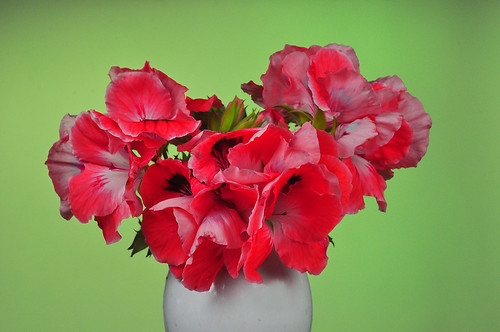Geraniums on Green
Image by Bill Gracey
My wife picked these this morning, and I decided to take a picture of them without my usual black background. For this I used a green gel over my SB600 strobe onto a white background for the contrasting colors. I then used an SB600 and a SB700 in softoxes on either side of the flowers in front at a 45 degree angle for flat even light. I'm not sure if this is an improvement over my usual dark background, but it is a different look. Both strobes were triggered by the pop up flash on my D90 in Commander mode.
Other plants and flowers that I've photographed using strobes can be seen in my Strobe Lit Plant set. In the description, I list resources that I've used to learn how to light with off camera flash. www.flickr.com/photos/9422878@N08/sets/72157628079460544/...
Dark Before the Morning
Image by JFXie
There’s gotta be more to life than this. And I’m gonna find it.
In my very first picture, I told you guys that you’d see my emotions through my pictures. I said that this would be like a diary. You’ll know when I’m happy or sad. Stressed or bored. Anyone wanna take a guess as to what I’m feeling today?? Jk. Don’t actually point it out :P
Yesterday, I was saying how I was interested in psychology, and the study of human behavior. Because of that, I’ve had this thing, where I can see which events will lead to this emotion or that behavior and whatever. That whole “emotional wreck” thing I mentioned 3 weeks ago, guess I was right about that :/
—sigh—
Well anyway, maybe you don’t wanna hear me rant. So here’s day 2 of the Tumblr Challenge
Nine things I can’t live without:
Psh. I can live without a lot of things. Buuuut I prefer to live with…(oh this will just be a quick list. I don’t really feel like elaborating today)
1. Computer 2. Food 3. God <—Wow, if I didn’t have him in my life, I would probably be dead by now 4. Bible 5. Genuinely nice people 6. Camera?? Eh. 7. Money… 8. Clothes 9. Smiles :) I need more smiles in my life.
That’s just an off-the-top-of-my-head-list in no particular order. So yeah. sdaighflkjvkd%#^Q$ %#@rehgiqjwod. Guys…it’s gonna be a tough week. And I mean…a TOUGH week. I really hope that this week goes smoother for everyone, than you think it will.
This song is written by a Christian music artist. But of course, you don’t have to be a Christian to listen to it. This always makes me feel better: www.youtube.com/watch?v=New8i_eX3x8
The really cool thing about this 365 (or any 365 I guess) is the time. The time from the first day, the the next year. The differences there will be. The similarities there will be. The things learned, the things that came true. The days where you suffered, the days of happiness. And one day, I will look back on this, and say: NBD.
54/365
Our House / Hosta
Image by bill barber
Built by Samuel Brookbank in 1859
From my set entitled “Hosta”
www.flickr.com/photos/21861018@N00/sets/72157607213588660/
In my collection entitled “The Garden”
www.flickr.com/photos/21861018@N00/collections/7215760718...
From Wikipedia, the free encyclopedia
en.wikipedia.org/wiki/Hosta
Hosta (syn.: Funkia) is a genus of about 23–40 species of lily-like plants native to northeast Asia. They were once classified in the family Liliaceae but are now included in the family Agavaceae by the Angiosperm Phylogeny Group. The scientific name is also used as the common name; in the past they were also sometimes called the Corfu Lily, the Day Lily, or the Plantain lily, but these terms are now obsolete. The name Hosta is in honor of the Austrian botanist Nicholas Thomas Host.[1]The Japanese name Giboshi is also used in English to a small extent. The rejected generic name Funkia, also used as a common name, can be found in some older literature.
Hostas are herbaceous perennial plants, growing from rhizomes or stolons, with broad lanceolate or ovate leaves varying widely in size by species from 1–15 in (3–40 cm) long and 0.75–12 in (2–30 cm) broad. Variation among the numerous cultivars is even greater, with clumps ranging from less than 4 in (10 cm) across to more than 6.5 ft (2 m) across. Leaf color in wild species is typically green, although some species (e.g., H. sieboldiana) are known for a glaucous waxy leaf coating that gives a blue appearance to the leaf. Some species have a glaucous white coating covering the underside of the leaves. Natural mutations of native species are known with yellow-green ("gold") colored leaves or with leaf variegation (either white/cream or yellowish edges or centers). Variegated plants very often give rise to "sports" that are the result of the reshuffling of cell layers during bud formation, producing foliage with mixed pigment sections. In seedlings variegation is generality maternally derived by chloroplast transfer and is not a genetically inheritable trait.
The flowers are produced on erect scapes up to 31 in (80 cm) tall that end in terminal racemes. The individual flowers are usually pendulous, 0.75–2 in (2–5 cm) long, with six tepals, white, lavender, or violet in color and usually scentless. The only strongly fragrant species is Hosta plantaginea, which is also unusual in that the flowers open in the evening and close by morning. This species blooms in late summer and is sometimes known as "August Lily".
Taxonomists differ on the number of species; as such, the list at the right may be taken loosely. The genus may be broadly divided into three subgenera. Interspecific hybridization is generally possible, as all species have the same chromosome number (2n = 2x = 60) with the exception of H. ventricosa, a natural tetraploid that sets seed through apomixis. Many varieties formerly described as species have been taxonomically reduced to cultivar status, while retaining Latin names resembling species (e.g., H. 'Fortunei').
Though Hosta plantaginea originates in China, most of the species that provide the modern shade garden plants were introduced from Japan to Europe by Philipp Franz von Siebold in the mid-19th century. Newer species have been discovered on the Korean peninsula as well.
Hostas are widely-cultivated ground cover plants, particularly useful in the garden as shade-tolerant plants. Hybridization within and among species and cultivars has produced numerous cultivars, with over 3000 registered and named varieties, and perhaps as many more that are not yet registered. Cultivars with golden- or white-variegated leaves are especially prized. Popular cultivars include 'Francee' (green leaves with white edges), 'Gold Standard' (yellow leaves with green edges was discovered by Pauline Banyai) 'Undulata' (green leaves with white centers), 'June' (blue-green leaves with creamy centers), and 'Sum and Substance' (a huge plant with chartreuse-yellow leaves). Newer, fragrant cultivars such as 'Guacamole' are also popular. Pictures of hosta species and cultivars, along with other information, may be found at www.hostalibrary.org.
The American Hosta Society and the British Hosta and Hemerocallis Society support Hosta Display Gardens, often within botanical gardens.
Hostas are notoriously a favourite food for deer, slugs and snails, which commonly cause extensive damage to hosta collections in gardens. Poisoned baits using either metaldehyde or the safer iron phosphate work well for the latter, but require repeated applications. Deer control tends to be variable, as anything other than fencing tends to work for a few years then cease to work as they become accustomed to it.
Foliar nematodes, which leave streaks of dead tissue between veins, have become an increasing problem since changes in attitudes about pesticides since the mid-1990s in many countries have caused a resurgence in this once-controlled pest. There are no effective means for eliminating nematodes in the garden, although they can be controlled to the point where little or no symptoms are seen.
A virus called Hosta Virus X has become common since 2004 and plants that are infected must be destroyed. It can take years for symptoms to show, so symptomless plants in infected batches should also be considered infected.
Otherwise they are generally easy and long-lived garden plants, relatively disease free, requiring little care other than watering and some fertilizer to enhance growth. Some varieties are more difficult to grow, as can be expected with 5,000+ cultivars, but most are easy enough for beginners.
From my set entitled “Smokebush”
www.flickr.com/photos/21861018@N00/sets/72157607213776358/
In my collection entitled “The Garden”
www.flickr.com/photos/21861018@N00/collections/7215760718...
From Wikipedia, the free encyclopedia
en.wikipedia.org/wiki/Cotinus
Smoketree or Smoke bush (Cotinus) is a genus of two species of flowering plants in the family Anacardiaceae, closely related to the sumacs (Rhus). They are large shrubs or small trees, native to the warm temperate Northern Hemisphere. The leaves are deciduous, alternate, simple oval shape, 3-13 cm long. The flowers are clustered in a large open terminal panicles 15-30 cm long with a fluffy grayish-buff appearance resembling a cloud of smoke over the plant, from which the name derives. The fruit is a small drupe with a single seed. Often classified in Rhus in the past, they are distinguished by the leaves being simple (not pinnate) and the 'smoke-like' fluffy flower heads.
The American Smoketree (Cotinus obovatus, syn. Rhus cotinoides) is native to the southeastern United States, from Tennessee south to Alabama and west to eastern Texas. It is a larger plant, frequently becoming a small tree up to 10-12 m tall and with a trunk up to 25 cm diameter. The leaves are also larger, 6-13 cm long; it also has varied but very bright fall color, usually brighter than the Eurasian species. The flower heads are usually sparser than in C. coggygria.
The smoketrees, particularly C. coggygria, are popular garden shrubs. Several bronze or purple-leaved cultivars of C. coggygria have been selected, with warm pink inflorescences set against purple-black foliage; the commonest in commerce are 'Notcutt's Variety' and 'Royal Purple'. When brought into cultivation together, the two species will form hybrids; some garden cultivars are of this parentage.
Cultivation is best in dry, infertile soils, which keeps the growth habit more compact and also improves the autumn colour; when planted in fertile soil, they become large, coarse and also tend to be short-lived, succumbing to verticillium wilt disease. Both species can be coppiced in early spring, to produce first-year shoots up to 2 m tall with large handsome leaves, but no "smoke".
Tidak ada komentar:
Posting Komentar